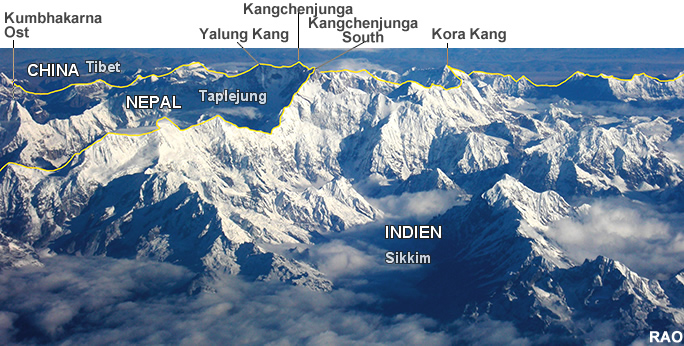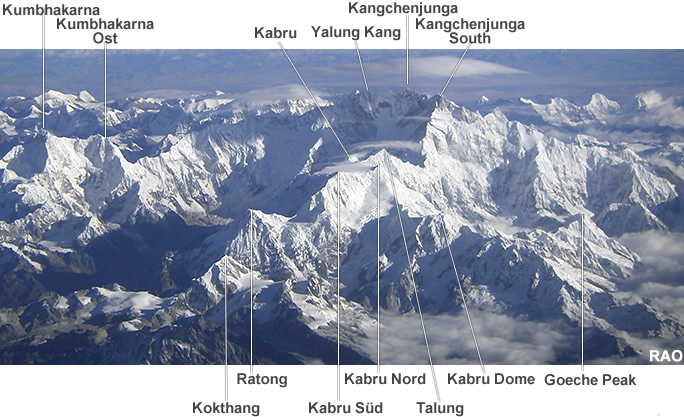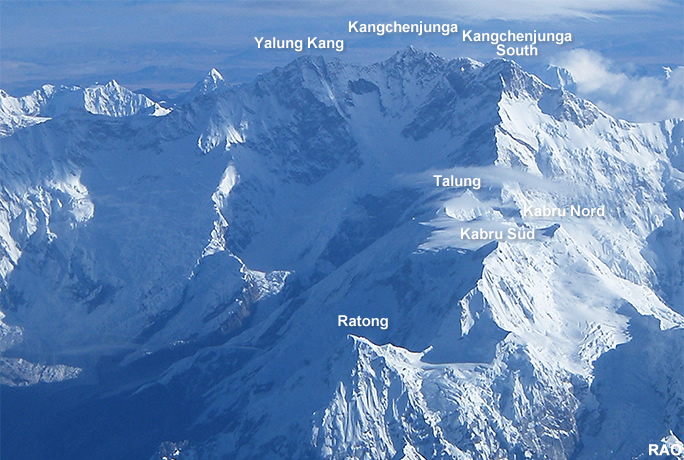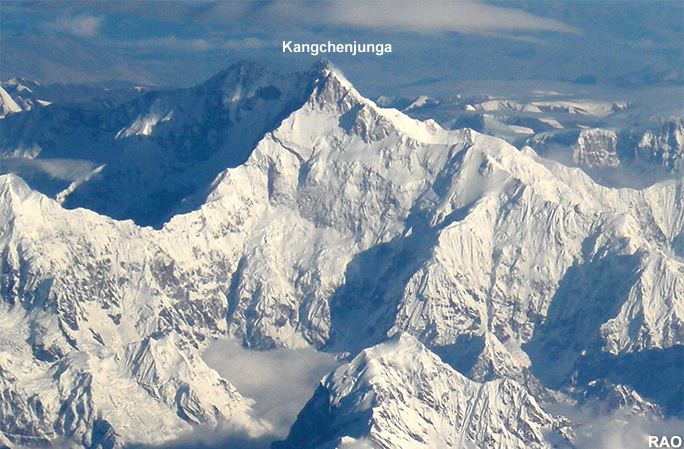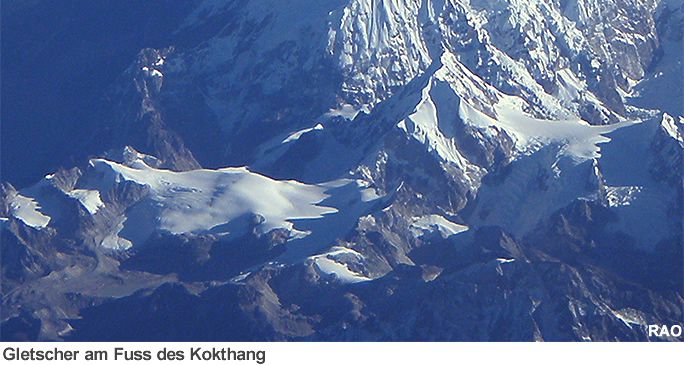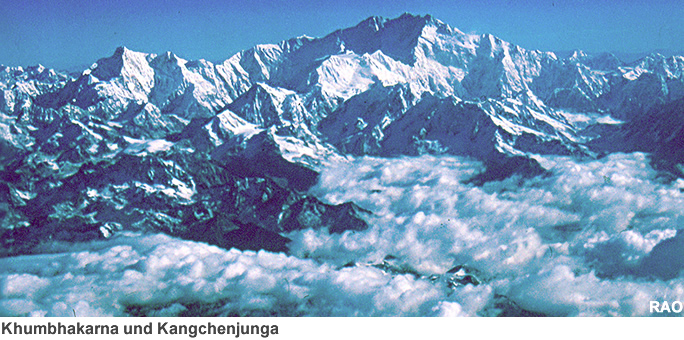| National
Parks and Wildlife Reserves of Nepal |
| Kangchenjunga Conservation Area |
 |
|
Kangchenjunga
|
Nepal's government has turned over conservation areas surrounding
Kangchenjunga - the world's third highest mountain - to a coalition of local
communities.
WWF,
the global conservation organisation, was instrumental in the decision
and will work with local communities to implement a conservation programme
for the area over the next five years.
Nepal's
State Minister for Forests and Soil Conservation, Gopal Rai, handed over
the management of Kangchenjunga Conservation Area (KCA) today to the Kangchenjunga
Conservation Area Management Council at a ceremony in Taplejung, Nepal,
in the mountainous eastern part of the country.
"I
am very happy to be part of this significant day when the people of Kangchenjunga
take on the responsibility of managing this conservation area," said Minister
Rai while addressing the community members gathered on the occasion.
"I
am convinced that the local communities will show even greater commitment
to saving the unique natural and cultural heritage of Kangchenjunga."
The
Kangchenjunga Conservation Area is known for its rich biodiversity, spectacular
scenery and vibrant cultural heritage. Launched in 1998, the Kangchenjunga
Conservation Area project is designed to conserve globally threatened wildlife
species such as the snow leopard and red panda while supporting the local
communities through health services, informal education and income generating
activities.
"This
is a historic day for one of the world's most spectacular natural treasures,"
said Mingma Norbu Sherpa, Director of WWF's Eastern Himalayas Programme.
"The decision shows the government's commitment to give power to local
communities, especially with regard to natural resources and equitable
sharing of benefits."
Since
1998, WWF has invested US$1.5 million in the Kangchenjunga Conservation
Area Project. In that time, pressure on local forests has decreased while
the positive attitude of locals toward wildlife conservation has increased.
In addition, wildlife poaching and illegal harvesting of valuable medicinal
plants have decreased and committees have been formed to monitor wildlife
movement and illegal activities. WWF will support the Kangchenjunga Conservation
Area Management Council for the next five years as part of its Sacred Himalayan
Landscape.
"This
is a great day for the people of Kangchenjunga," added Dawa Tshering Sherpa,
chairman of the KCA Management Council, which was formed in 2000 to represent
all stakeholders in the Kangchenjunga region. "We are ready to take on this
responsibility thanks to capacity building and local development supported
by organisations like WWF."
Dr
Chandra P. Gurung, WWF's Country Representative in Nepal, said he, on behalf
of WWF, was very proud to be part of this effort.
"The
handover will be held up around the world as a positive example of people
managing their natural resources and enable others to learn how to make
conservation more equitable and sustainable," he said.
 The Kangchenjunga
Conservation Area is known for its rich biodiversity, its spectacular
scenery, including Mount Kangchenjunga (8586m), and rich cultural heritage
represented by the 5,254 inhabitants living within the four Village Development
Committees (VDCs) of Lelep, Olangchung Gola, Tapethok and Yamphudin. In
support of WWF's Living Planet Campaign, the area was declared A Gift to
the Earth in April 1997. The Kangchenjunga
Conservation Area is known for its rich biodiversity, its spectacular
scenery, including Mount Kangchenjunga (8586m), and rich cultural heritage
represented by the 5,254 inhabitants living within the four Village Development
Committees (VDCs) of Lelep, Olangchung Gola, Tapethok and Yamphudin. In
support of WWF's Living Planet Campaign, the area was declared A Gift to
the Earth in April 1997.
 The Sacred
Himalayan Landscape (SHL) Programme is designed to conserve the landscapes
surrounding the mountains of the eastern Himalayas while improving local
livelihoods, in particular, a Himalayan landscape where the biological
and cultural treasures of the world's highest sacred mountains and deepest
valleys are safeguarded while traditional rights over resource use are
ensured, and livelihoods of mountain people are enhanced and sustained.
The programme has been endorsed by Nepal's Ministry of Forests and Soil
Conservation. A Sacred Himalayan Landscape Strategic Plan has been prepared
under the leadership of the ministry and key partner. The Sacred
Himalayan Landscape (SHL) Programme is designed to conserve the landscapes
surrounding the mountains of the eastern Himalayas while improving local
livelihoods, in particular, a Himalayan landscape where the biological
and cultural treasures of the world's highest sacred mountains and deepest
valleys are safeguarded while traditional rights over resource use are
ensured, and livelihoods of mountain people are enhanced and sustained.
The programme has been endorsed by Nepal's Ministry of Forests and Soil
Conservation. A Sacred Himalayan Landscape Strategic Plan has been prepared
under the leadership of the ministry and key partner.
Source: WWF
Nepal 22 Sep 2006
nach
oben
 |
| Makalu |
| 


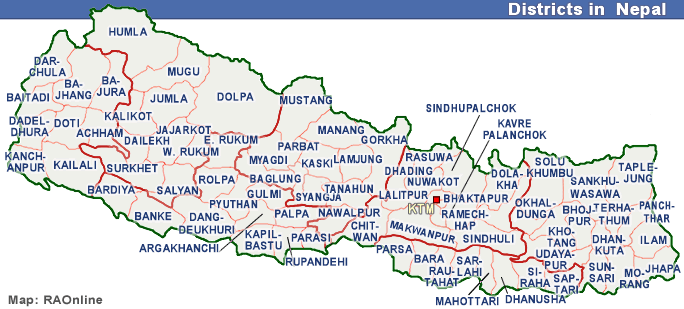
![]() The Kangchenjunga
Conservation Area is known for its rich biodiversity, its spectacular
scenery, including Mount Kangchenjunga (8586m), and rich cultural heritage
represented by the 5,254 inhabitants living within the four Village Development
Committees (VDCs) of Lelep, Olangchung Gola, Tapethok and Yamphudin. In
support of WWF's Living Planet Campaign, the area was declared A Gift to
the Earth in April 1997.
The Kangchenjunga
Conservation Area is known for its rich biodiversity, its spectacular
scenery, including Mount Kangchenjunga (8586m), and rich cultural heritage
represented by the 5,254 inhabitants living within the four Village Development
Committees (VDCs) of Lelep, Olangchung Gola, Tapethok and Yamphudin. In
support of WWF's Living Planet Campaign, the area was declared A Gift to
the Earth in April 1997.
![]() The Sacred
Himalayan Landscape (SHL) Programme is designed to conserve the landscapes
surrounding the mountains of the eastern Himalayas while improving local
livelihoods, in particular, a Himalayan landscape where the biological
and cultural treasures of the world's highest sacred mountains and deepest
valleys are safeguarded while traditional rights over resource use are
ensured, and livelihoods of mountain people are enhanced and sustained.
The programme has been endorsed by Nepal's Ministry of Forests and Soil
Conservation. A Sacred Himalayan Landscape Strategic Plan has been prepared
under the leadership of the ministry and key partner.
The Sacred
Himalayan Landscape (SHL) Programme is designed to conserve the landscapes
surrounding the mountains of the eastern Himalayas while improving local
livelihoods, in particular, a Himalayan landscape where the biological
and cultural treasures of the world's highest sacred mountains and deepest
valleys are safeguarded while traditional rights over resource use are
ensured, and livelihoods of mountain people are enhanced and sustained.
The programme has been endorsed by Nepal's Ministry of Forests and Soil
Conservation. A Sacred Himalayan Landscape Strategic Plan has been prepared
under the leadership of the ministry and key partner.

